|
|
|
Traditional Stories
We teach our children about our history and culture through our stories. Many of these stories are very old and explain how the spirits of plants and animals have helped us to survive. These stories have important messages that explain how we, as Niisitapi, should behave. They also show us the consequences of not acting properly. Our grandmothers would tell us these stories in the evenings when we were calm and could pay attention to their meanings. |
|
|
 |
Six Neglected Boys
One spring some of our people were camped on the prairie, hunting buffalo. As the men left camp, their sons asked them to bring back the red hide of the unborn calves. All the men promised to do so.
Later that day, as the hunters returned, several boys discovered that their fathers had forgotten to bring the hides home. The boys were very disappointed and left the camp. As they wandered about the prairie they discussed where they should go. At last they decided to go up to the sky where no harm could come to them.
We still see these boys as the bunch stars, or Pleiades. This constellation disappears in the spring, when the buffalo calves are born with their red hides, but it returns in the fall when the hides have turned dark brown.
We also paint these stars on the ear flaps of our tipis to remind us to care for our children.
Listen to the story in Blackfoot (1m 56sec, 684KB)
top
|
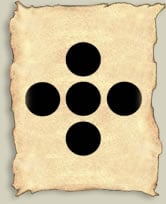 |
Courtesy of Glenbow Museum |
| |
|
 |
|
 |
|
Iniskim (Buffalo Calling Stones)
Although our people began to live as
makoyi (wolves) had shown them, life was still very hard and the people were often hungry. One day
iinii (buffalo) took pity on our people.
A lady named Weasel Woman was collecting water from a river near her camp when she heard something calling to her from the bushes. When she looked closer, she found a stone that spoke to her. The stone explained how it could be used in a ceremony that would call the buffalo towards a
pisskan (buffalo jump).
Weasel Woman took the
iniskim, the buffalo calling stone, back to camp. She told the spiritual leaders about the ceremony to call the buffalo. The people followed her instructions and soon they had plenty of meat and many hides for new lodge covers.
There are numerous
iniskim on the prairies. Many people still keep them as sacred bundles. We call on
iniskim to help us have successful lives.
Listen to the story in Blackfoot (1m 51sec, 654KB)
top
|
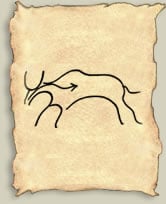 |
Courtesy of Glenbow Museum |
| |
|
 |
|
 |
|
Katoyissa (Blood Clot)
An old couple camped with their son-in-law who was married to three of their daughters. The son-in-law was very cruel. He made the old man chase buffalo for him but did not share the food with the old couple. Only the youngest daughter helped the old couple and took food to their lodge.
One day the old man found a clot of blood on the prairie. He hid it from his son-in-law and took it to his wife, telling her to cook it in a soup. As the water boiled the old couple heard a baby crying. Looking into the pot, they saw a child who instructed them to take him out and hold him up to each pole in the lodge. As the old couple did so the child grew and became a young man named
Katoyissa, or Blood Clot. After hearing the old people's story,
Katoyissa devised a plan to kill the son-in-law and the daughters who did not help their parents.
Once he saved the old couple,
Katoyissa travelled throughout our territory, saving our people from various evil beings who kept them captive. When
Katoyissa was finished, our people were free to travel throughout the territory
Ihtsipaitapiyopa (the Creator) had given them. The world was now safe for our people.
We believe that
Katoyissa now sleeps at the place called the Sweet Grass Hills, although we call them Katoyissiksi, the Sweet Pine Hills.
Listen to the story in Blackfoot (2m 27sec, 863KB)
top
|
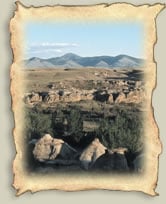 |
Courtesy of Glenbow Museum |
| |
|
 |
|
 |
|
Ksiistsikomm (Thunder)
Ksiistsikomm, Thunder, was jealous of a man and wanted his wife. He struck their lodge, knocked them unconscious, and stole the woman. When the man recovered he wandered all over, asking many animals to help him find his wife. All were afraid of Thunder. Finally,
Omahkai’stoo (Raven) agreed to help. He flew to Thunder's home and challenged him.
Ksiistsikomm shot lightening bolts at
Omahkai’stoo, trying to kill him. But
Omahkai’stoo used his own power and, by flapping his wings, brought on the cold north wind and snow. Gradually, the cold slowed down
Ksiistsikomm until he could no longer send out the dangerous bolts of lightening. It was a long battle, but eventually
Ksiistsikomm gave up and returned the man's wife.
Omahkai’stoo insisted that he and
Ksiistsikomm divide the year into two parts: winter, which is
Omahkai’stoo's season, and summer, which is
Ksiistsikomm's time.
Omahkai’stoo also ordered
Ksiistsikomm to make a peace treaty with the man and to give our people his pipe as a sign of this agreement. Since that day we have opened our Thunder Medicine Pipe Bundles each spring at the first sound of thunder. We ask for good weather, good crops, and good luck for the coming year.
Listen to the story in Blackfoot (2m 22sec, 837KB)
top
|
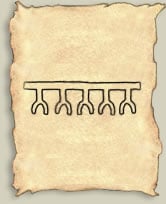 |
Courtesy of Glenbow Museum |
| |
|
 |
|
 |
|
Makoyoohsokoyi (The Wolf Trail)
Makoyiwa, the wolves, were some of the first Earth Beings to help us.
One winter, when our people were starving, a young man and his family were camped by themselves as they searched for food. The wolves found the family and appeared to them as young men bringing fresh meat to the lodge. The wolves took this family with them, showing the man how to cooperate with other people when he hunted buffalo and other animals. The wolves introduced the people to the other animals in their world. The human beings learned that animals with hooves and horns were all right to eat, but that animals with paws and claws should be left alone.
The wolves disappeared in the spring, but we still see them in the sky as
makoiyohsokoyi, the Wolf Trail (the Milky Way). These stars constantly remind us of how we should live together.
Listen to the story in Blackfoot (1m 44sec, 616KB)
top
|
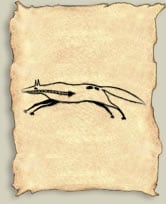 |
Courtesy of Glenbow Museum |
| |
|
 |
|
 |
Napi and the Black Birch
One time
Napi was walking about when a great storm came up. The strong wind began to blow him all over the place. He grasped at the branches of trees and bushes as he went by, but they all broke off in his hand. Finally, he clutched at a birch tree. The flexible birch bent, but did not break and
Napi was able to stop.
When the storm died down,
Napi climbed out of the tree and began beating it with a stick. “Why did you stop me? I was having such fun being blown about by the big wind!” The marks left by the beating are still visible on the striped bark of birch trees.
We learned from this story that black birch makes good tipi pegs and will always hold our lodges down in a wind storm.
Listen to the story in Blackfoot (1m 26sec, 507KB)
top
|
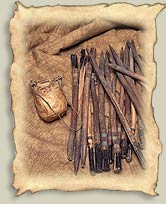 |
Courtesy of Glenbow Museum |
| |
|
 |
|
 |
Napi and the Bull Berries
One day
Napi went out to pick berries. He came to a bull berry bush that had so many berries on it that the branches were almost bent in half. When he tried to pick the berries, the thorns on the branches tore his clothes and scratched his skin.
Napi could not pick any berries and became very angry.
Later, after the first frost,
Napi returned to the bush. This time, before he tried to pick the berries, he picked up a stick and began to beat the bush, punishing it for having scraped him and torn his clothes. The berries easily fell from the branches and were very sweet.
We always collect bull berries by beating the bush so that we won't get scratched by the thorns. The berries are quite bitter until after the first frost, when they become sweet.
Listen to the story in Blackfoot (1m 30sec, 531KB)
top |
Napi (Old Man)
Napi, Old Man, always acted on impulse. He was rude, mean, and stingy. He often lied and played dirty tricks. He was always getting into trouble and suffering the consequences of his bad behaviour. And yet, he did not act out of malice. He merely overdid things and caused chaos as a result.
One of our basic principles is to live a balanced life, and our stories about
Napi teach us the importance of this.
Napi went to extremes and failed to maintain a balance.
Napi's adventures also teach us about our environment. We learn why wolf willow (or silverberry) smells bad when it is burned. We learn why we use black birch for tipi pegs. We learn why we collect bull berries only after the first frost and by beating the bush rather than by picking the berries.
Napi's impulsive behaviour left our world all mixed up. There was no order. It was a dangerous place for our ancestors.
Listen to the story in Blackfoot (1m 52sec, 658KB)
top |
 |
|
|

